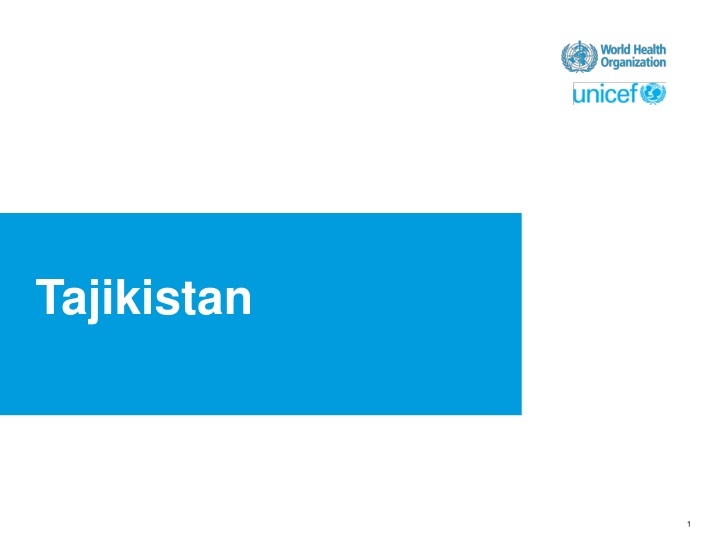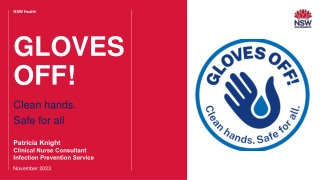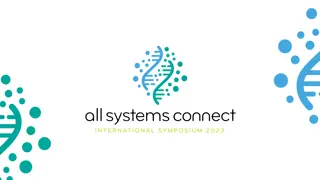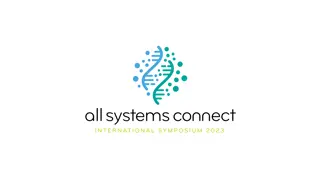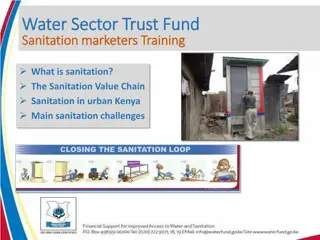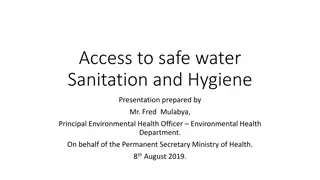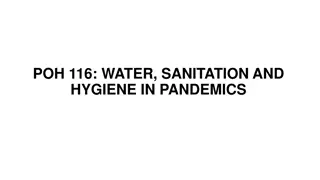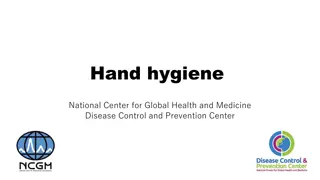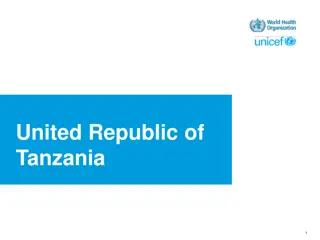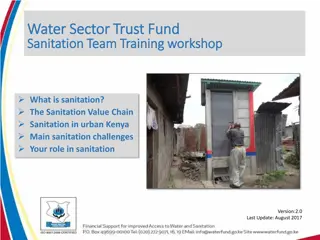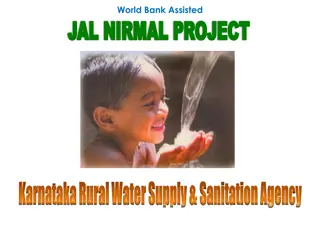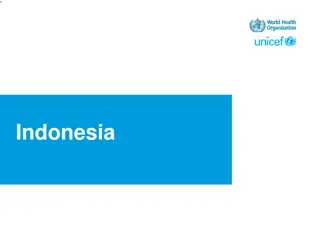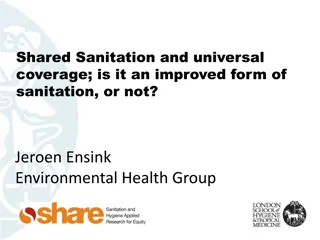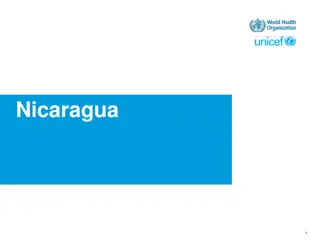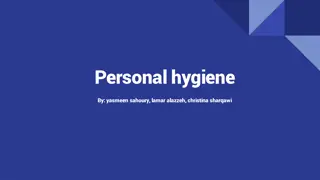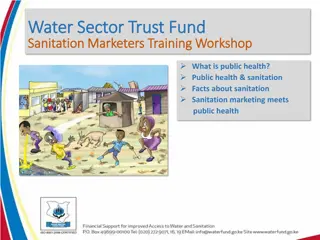Improving Water, Sanitation, and Hygiene in Healthcare Facilities: Initiatives in Tajikistan
Tajikistan is taking steps to enhance WASH facilities in healthcare settings through conducting assessments, establishing baselines, and developing national roadmaps aligned with global goals like SDGs. Initiatives include identifying underserved areas, implementing WASH FIT programs, and aiming for sustainable progress.
Download Presentation

Please find below an Image/Link to download the presentation.
The content on the website is provided AS IS for your information and personal use only. It may not be sold, licensed, or shared on other websites without obtaining consent from the author.If you encounter any issues during the download, it is possible that the publisher has removed the file from their server.
You are allowed to download the files provided on this website for personal or commercial use, subject to the condition that they are used lawfully. All files are the property of their respective owners.
The content on the website is provided AS IS for your information and personal use only. It may not be sold, licensed, or shared on other websites without obtaining consent from the author.
E N D
Presentation Transcript
1. Establish baseline What: Conduct comprehensive assessments according to the national context and, where appropriate, to quantify: the availability and quality of, and needs for safe water, sanitation and hygiene (WASH) in health care facilities; and infection prevention and control (IPC) using existing regional and global protocols or tools and in collaboration with the global effort to improve WASH in health care. Trigger questions on WASH baseline data Q1. Does your country have a baseline for WASH in HCF? If yes, share information below on the status of water, sanitation, health care waste, hygiene and cleaning. If not, share information on your plans for establishing such a baseline. Q2. Have underserved areas been identified? If yes, share information below on what/where these are are and how they are being targeted for improvement. Baseline data/plans for establishing baseline data: Existing national policies and standards related to WASH in HCF is reviewed and gaps/needs are identified Information on underserved areas: Based on a comprehensive survey of WASH in healthcare facilities the undreserved areas were identified.. The findings of the survey can serve as a baseline to track the progress against established goals and objectives. 2
2. Develop and implement roadmap What: Develop and implement a road map according to national context so that every health care facility in every setting has, commensurate with its needs: safely managed and reliable water supplies; sufficient, safely managed and accessible toilets or latrines for patients, caregivers and staff of all sexes, ages and abilities; appropriate core components of infection prevention and control (IPC) programmes, including good hand hygiene infrastructure and practices; routine, effective cleaning; safe waste management systems, including for excreta and medical waste disposal; and, whenever possible, sustainable and clean energy. Trigger questions on national roadmaps Q1. Has your country started the process of developing a national roadmap? If yes, what are the key elements included and what is the plan to finalize and implement? Q2. What specific targets are included and how do the activities map to sustainable development goals (SDG) efforts, especially those on WASH and health? Process, key elements & finalization/implementation plans of national roadmap: Tajikistan does not start RM development but initiated introduction of WASH FIT through increasing awareness on global and regional commitments and actions related to WASH in health care facilities as foundation for national uptake in policies and regulations; piloting an application of WASH FIT in a selected health facility as basis for further scale up across the country; reviewing and updating standards for WASH in health care facilities and embedding WASH related requirements into quality improvement, infection prevention and control and maternal and child health efforts; and monitoring and evaluating progress on WASH FIT and document lessons learned to further improve the tool WASH FIT activities are divided into four phases: 1) preparation; 2) training; 3) implementation and 4) follow up/monitoring and evaluation. These may be adapted in the local context as needed. Targets and linkages to SDGs: Target 3.1 on reducing maternal mortality, target 3.2 on ending preventable newborn deaths, target 3.3. on combating waterborne disease and target 3.8 on providing quality universal health coverage; 3
3. Establish and implement standards What: Establish and implement, according to national context, minimum standards for safe water, sanitation and hygiene (WASH) and infection prevention and control (IPC) in all health care settings and build WASH and IPC standards into accreditation and regulation systems; and establish accountability mechanisms to reinforce standards and practice. Trigger questions on standards Q1. Does your country have standards for WASH in health care facilities? Q2. What are the key elements in the standards and when were they last updated? Q3. Are there any gaps in these standards and if so, what are these gaps and how will they be addressed? Q4. How are these standards regulated, if at all? The status of national standards including gaps and plans to address: While basic requirements on water and sanitation infrastructure and procedures are in place, standards do not comprehensively consider important aspects such as costing, implementation and operation of WASH services, or responsibilities. Standards do not consider roles and capacity building of cleaners, and cleaners may lack the skills necessary to implement the standards. Requirements for water supply and wastewater systems are not specific to healthcare facilities. Such norms date back to the Soviet Union (e.g. SNiP 03.05.04-85) and are often outdated and impractical, especially for smaller systems. Continuity of water provision (TBC), measures for controlling bacterial spread and Legionella in water systems, which can be a serious source for nosocomial infections, and standards for the quality of water for medical purposes or vulnerable patients are not addressed. A considerable gap in the standards is the lack of requirements for on-site systems, which are commonly found in rural areas, where centralised water supply and sewage system are rarely available. Hygiene requirements are particularly comprehensive. Order no.1119 (2014) addresses measures for the prevention of HAI and provides control measures in case of an outbreak, also addressing some requirements for water, wastewater systems, cleaning, laundry, and detailed indications on hand hygiene and use of gloves as well as protective equipment. 4
4. Set targets and monitor progress What: Set targets within health policies and integrate indicators for safe water, sanitation and hygiene (WASH) and infection prevention and control (IPC) into national monitoring mechanisms to establish baselines, track progress and track health system performance on a regular basis. Trigger questions on targets and monitoring Q1. What are your targets for WASH in HCF? Q2. Are high risk settings prioritized (e.g. maternity wards)? Q3. What is the process for assessing progress towards achieving these targets? Q4. How is progress incentivized? Overview of targets and prioritization: WHO and Government to coordinate efforts for follow up and evaluate the outcomes of WASH FIT implementation in the pilot facilities (using WHO/UNICEF evaluation tools) 3 months, 6 months and one year post training and report on the specific improvements in pilot facilities; Document and share lessons learned of implementation and contribute experience and learnings to regional and global events and documents on WASH in health care facilities The activities will be linked with the ongoing project Small and safe concerned with WSP uptake in rural Tajikistan. The activities will inform policy uptake of safe WASH services in the health sector in Tajikistan, and thereby support implementation of international and national goals and commitments. This includes sharing information and providing updates to the knowledge portal (www.washinhcf.org). 5
5. Integrate WASH into health programming What: Integrate safe water, sanitation and hygiene (WASH) into health programming, including into nutrition and maternal, child and newborn health within the context of safe, quality and integrated people-centred health services, effective universal health coverage, infection prevention and control (IPC) and antimicrobial resistance. Trigger questions on integrating WASH into health programming Q1. What are the key opportunities in specific national health programmes for WASH in health care facilities? Q2. In what ways has WASH in health care facilities been included (e.g. in training, in monitoring, etc)? Q3. What further integration needs to happen and what is the plan for doing so? Key opportunities for integration & examples: The 2018 national action plan for AMR now includes action towards strengthening IPC through adequate measures for water supply, sanitation and hygiene in healthcare facilities, an outcome of the increased attention of WASH after the launch of the WASH FIT pilot. WASH in HCF reflected in National Target setting in the frame of Protocol on Water and Health A New National Health strategy for the period 2020-2030; Revision of Sanitary Regulations and Norms 2.1.7.020-09; Sanitary Protection Of Soil Rules Of Collection, Storage And Disposal Of Health Facility Wastes . 6
6. Allocate regular funding What: Have procedures and funding in place to operate and maintain safe water, sanitation and hygiene (WASH) and infection prevention and control (IPC) services in health facilities, and to make continuous upgrades and improvements based on needs so that infrastructure continues to operate and resources are made available to help facilities access other sources of safe water in the event of failures in the normal water supply, so that environmental and other impacts are minimized and in order to maintain hygiene practices. Trigger questions on regular funding Q1. Have capital and operation and maintenance expenditures for WASH in health care facilities been costed? Q2. Is there a budget line within Ministry of Health? Is so, what is it, and what is the gap? Q3. What plans are in place to fill in, any gaps around costs and financing? Country funding/current budget lines: The state budget allocated to the health sector is insufficient to ensure water supply and sanitation in all medical institutions in the country. Funds from the state budget provided to the facilities do include line items that can be used for WASH services and their maintenance, these are mandatory for national and local facilities, but the actual expenditures for WASH are not monitored. This is partly because of the current lack of dedicated line(s) for WASH expenses, which are partly considered in the following general budget lines not necessarily with clear breakdowns, including: Payable communal services (water, electricity, waste, heat); Maintenance; Sanitary products (chlorine and disinfectant); Procurement. Furthermore, the facility managers have no space for freedom in the use of the budget, due to the strict budget lines and because they do not own the money. The finance departments of the local administration actually pay salaries and other expenditure upon request and if there are enough funds in the budget line Plans to address gaps: 7 A pilot project currently conducted in 10 districts at the primary healthcare level consists in allocating budget based on improvements
7. Establish a multisectoral coordination mechanism What: Establish strong multisectoral coordination mechanisms with the active involvement of all relevant ministries, particularly those responsible for health, finance, water, and energy; to align and strengthen collaborative efforts and ensure adequate financing to support the delivery of all aspects of safe water, sanitation and hygiene (WASH) and infection prevention and control (IPC) across the health system. Trigger questions on multisectoral coordination mechanisms Q1. Is there a national multisectoral committee that coordinates, advocates and plans for efforts on WASH in health care facilities? If so, what are the key responsibilities and what has been accomplished to date? Q2. How can such a committee be strengthened? Country multisectoral coordination mechanism, responsibilities & accomplishment There is no any multisectoral mechanism that address all aspects of the WASH in HCF, < establishing Intersectorial working group for developing WASH in HCF road map would be good as of first step > 8
8. Develop a health workforce What: Invest in a sufficient and well-trained health workforce, including health care workers, cleaners and engineers to manage WASH services, provide ongoing maintenance and operations and perform appropriate WASH and IPC practices, including strong pre-service and ongoing in-service education and training programmes for all levels of staff; educate and raise awareness, in line with regional agreements, on water, sanitation and hygiene, with a particular focus on maternity, hospital facilities, and settings used by mothers and children Trigger questions on developing a health workforce Q1. What kind of training, mentoring and/or investments in health workforce have taken place to support the safe use and maintenance of WASH in health care facilities services? Q2. Has the WASH FIT or other similar tools been used and adapted? If so, in how many facilities and what has been the key results? Training, mentoring and/or investments in process or planned: Three days WASH FIT training for 3 potential trainers; staff from 3 pilot health care facilities and other relevant people in 2018; National level meeting for decision makers to identify country priorities, needs and discuss plans to introduce WASH FIT 2018. Proposed participants are staff from the Ministry of Health responsible for health systems strengthening, quality of health care services, infection control and prevention, maternal and child health; environmental health, health financing, hospital managers (especially from pilot hospitals), staff from SES, UNICEF and other relevant partners. Use/adaptation of WASH FIT (or other tools) including numbers of facilities and key results: 9 Introduction of WASH FIT in 3 pilot HCF through providing trainings and establishing WASH FIT teams;
